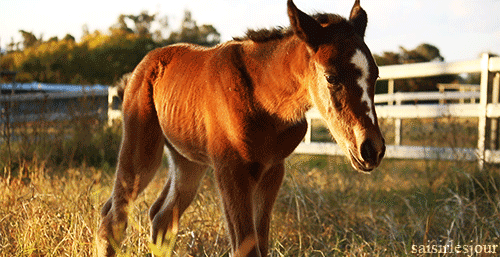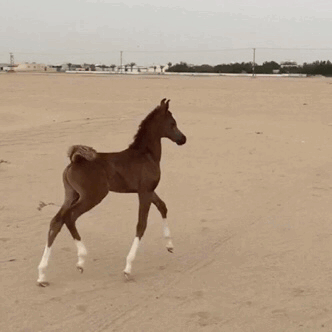Welcome to Finance Friday 2018! All year long, we’ll talk about personal finances on the first Friday of the month, with the goal to getting us all in better overall financial shape. We know horses are expensive, and we need to be ready as we can for those expenses – both planned and unplanned.

Each month, I’ll cover a topic or invite a guest poster to cover a topic. We’ll do an overview that takes into account varying approaches, offer up some additional reading (both from other horse blogs and from the personal finance world), and pose a question for everyone. We’ll also use these monthly posts as check ins for everyone on how they’re doing with the goals and obstacles that they laid out in January.
We’ll be relieving the stress of talking about money with gifs of cute foals.
This month, we’re starting at square one: budgeting.

What is a budget?
Let’s start realllllly simple. It’s not that I think anyone is dumb! It’s that I want to start at square one so that we can explore some of the philosophy and utility behind budgeting.
Put simply, a budget is a tallying of finances. It accounts for money coming in (revenue) and money going out (expenses). Budgets can be project-based (say, a budget that’s written just for your show season) or they can be all-encompassing (every penny you make and earn in a given period). Most people use some combination of both. I see a lot of horse people with different levels of budgets – maybe one for just the show season, then a second for horse expenses, and then maybe a third for their overall finances. Like nesting budgets, each with different purposes and each at a different level of detail.
You can look at a budget from the point of view of expenses or revenue. An expenses budget would look at everything it costs to do something – say, have a summer of showing – and then tallies that money up to a total number that you either have to allocate or raise. A lot of project-based budgets work best in that way. A revenue budget, on the other hand, would look at money coming in and then allocate that money to different purposes – rent, food, gasoline, board, new tack, etc.
Budgets can have different levels of specificity. You can plan out your show season down to the smallest detail: gas to and from, food purchased at the show, hotel room, entry fees, trainer fees, a percentage off the top for shopping at the fair or contingency, etc. to infinity. Or you can make an educated guess: I know that an average entry fee is X, an average tank of gas is Y, and I usually spend Z on food.
The good news? There’s really no wrong way to do it. Go with what works for you. If granular detail makes you crazy, go bigger picture. If you feel more in control and less harried if you’ve planned everything out, then by all means sit down with a glass of wine and start making alllllll the lists.
The most important thing is that you budget.

How do I create a budget?
There are two schools of thought on creating a budget.
The first says to take a period of time and to track your expenses over that period of time. Sit down with a highlighter, pen and paper, and start just putting things into categories. What are you spending money on, and where is it going? When you have finished, you have a clear idea of where you have spent money in the past, and so a realistic idea of what some of your necessities costs and what you’ve been spending on more discretionary things. You can then tweak your spending up or down in certain areas.
The other school of thought is more top-down, and it starts with your revenue. How much money do you make in a month? Start with that number at the top. Now start parceling it up. You do need some basic information to do this – how much you spend on major things – but the idea is more that you are looking at bigger categories and writing it a bit more aspirationally.
A subset of these two types is the two ways that you can account for things in your budget. You can either allocate every single penny – or you can allocate for the major ongoing expenses and categories of expense, and then let the rest be leftover – for fun money, or savings, or whatever you want.
Either way works for people. If this is the first time you’ve ever created a budget, then you have to do some of the work in the first way, just to get a clear-eyed picture of where they money is actually going. It can be a good idea to revisit it after major life changes to see if you need to tweak it.
I tend to hold with the second: I look at what my monthly income is, and write a budget from there. I also dedicate every single penny of my income to some purpose – which means I have four different budget categories for savings accounts, with according monthly transfers. I find that method a bit easier for those of us who might not make a whole ton of money (yay nonprofits!). It’s not like I have enough money and am just spending it in slightly unwise ways. There’s never enough, and I need to give every single penny a job to do, and keep it in marching order.

Budgets only work if…
1.) You track your expenses. There are a lot of ways to do this. You can use online services like Mint or You Need a Budget, and some banks also provide budgeting tools online. You can use a simple Excel spreadsheet held in a place that you can get to easily – say in Google Docs or Dropbox. You can use good old-fashioned pen and paper. The only right way to do it is the way that works best for you, that holds you accountable and gets you to track every penny you spend. Yes, all of it. Make it an ironclad habit.
2.) You’re honest with yourself. Actually, none of this personal finance stuff works if you’re lying to yourself. That includes “yes, I will totally only spend $20 this month on going out with friends!” and “it’s fine, I know my budget line says this but I can totally make that up by doing less later in the month!” No one on earth is so perfect that they don’t feel the temptation to lie to themselves about this stuff. We all justify, prevaricate, and squirm when we’re faced with these internal narratives. We’re human, and that’s okay! The best way to deal with it is to understand and be kind to ourselves, but also be clear-eyed and honest as much as possible.
3) You hold yourself accountable. That means two things: first, it means picking a regular time (weekly, monthly, whatever) to check in and ask questions. Did I track everything this week? Do I have to fill in gaps? Did I go overboard on one thing? What’s my realistic plan for getting to the end of this period and still meeting my goals? What do I still have left that needs to get done, and do I have enough in the budget to do that? What should I say yes or no to based on the answers to those questions? Second, it also means also asking big questions of your budget each month. Does it need to be adjusted more generally? Were you too hard on yourself when you set a certain goal? Not hard enough? Did you have a major or minor life change that means you need to rethink some of your planning?

In Conclusion
Budgets are tools. Think of them like crops: they can be horrible or they can be useful, entirely depending on how they’re applied. They not in themselves inherently bad. I think a lot of times when we say “on a budget” or “not in my budget” we’re thinking in terms of a negative. We feel like budgets don’t let us do the things we really want.
If you think that way, reframe it. Budgets are a way for you to do the things that you really want. They are a neutral tool that you can pick up and use in your life to achieve great things. That doesn’t mean they’re easy, quick, or even simple. But it doe mean that if you work with them instead of against them, you’ll get a lot further.
Additional Reading
The Dangers of Heroic Budgeting from The Simple Dollar (and my response) – why going overboard can set you back
Changing the Ways I Save for Horse Shows from Cob Jockey – a good example of project-based budgeting
2017 Equine Expenditures from Hand Gallop – and here’s an overall horse budget
Our Budget from The Horse Rescue – this is a really detailed projected budget for what it would take to rescue a certain number of horses, and it can easily be adapted to your situation too
Doing the Math from Bel Joeor – an accounting I did of every penny I spent on one specific veterinary issue
These 4 Easy Steps Will Teach You How To Budget (Finally) from Money Under 30 – yes, it’s a clickbaity title, but it breaks down a lot of the steps in creating a budget and fleshes out the psychology behind them
The 50/20/30 Rule for Minimalist Budgeting from Mint Life – too may steps? here’s a really simple approach
Horses are Expensive from Not So Speedy Dressage – a phenomenal example of tracking expenses, actually a series of posts over the course of a year

Feedback & Check In
So, do you have a budget, whether project-specific or overall? What works for you, and what doesn’t? Is there anything that you’ve learned the hard way?
And: let’s check in! How are you doing on that goal you set for yourself? Give yourself a good old-fashioned letter grade, and think a little bit on what you can change for next month if it didn’t go great. If it did go well, think about what really worked for you. Similarly, how are you doing at that obstacle you named?
Feel free to answer in the comments, in your own head, or on your own blog.

I am usually ‘careful’ in how I spend money. I decided that this year I was going to track exactly what I spend on shows/training/etc. I may regret that decision….
LikeLike
I use mint for my budget and I like allocating every penny. I use the 50/20/30 rule as a general guideline but try to keep Housing/Fixed below 50 (hard to do in California but I’ve somehow managed) I try to keep savings above 30% (I do count my employer match as part of that) and personal discretionary spending below 20%. So far I’ve managed ok. I do also track goals separately in my bullet journal (color in graph) this makes it a bit visual and fun!
LikeLike
Tracking my expenses last year gave me a good idea of what I could expect to spend this year, as well as showing me where I could reduce spending or reallocate funds.
I did really well in January! I put $225 in my hay savings account- 15% of my $1500 hay goal! And the only thing I bought at work was a birthday gift for a friend and some horse treats for Moe. A+++ I need every month to be like this, hahaha.
LikeLike
I used to budget, but I’ve gotten out of the habit now that I don’t need to. But I don’t think that’s a good thing. I end up spending way too much on everything because it’s always affordable. IE: I can afford this $20 saddle pad, I can afford this extra lesson or XC schooling, but at the end of the year I’ve spent way more than I really should have.
LikeLike
I’m horrible at budgeting but am going to try! My goal is to have some nice spending money, as well as pay for our flight to Ireland this fall.
LikeLike
I’m not a good budgeter. But we use Mint.
LikeLike
We love mint, and I keep a separate, more detailed excel of my equine-related expenses. It actually brings me a lot of comfort since my main panic is “where did my money go”. At least now I understand what is happening.
That said, I know that being out of the saddle some this year will definitely help that side of the budget, but it means that this year won’t be applicable for next year really. Interesting to keep in mind as I go.
LikeLike
In 2011 I started budgeting. It began as very simple spreadsheet where I simply wrote down what I spent money on, how much I spent, how I paid for a thing, and summed my expenses. Ouch. That was bad. Mostly just showed that I hemorrhaged a lot of money every month.
I later modified it to have some goals, but the format was still too open and messy.
THEN I took it and got serious in 2012. I created a very anal-retentive spreadsheet with categories for each big area of my life – auto/gas, food/grocery, horses, pets, car payment, savings, insurance, rent, board, etc. Each category had a quantity that I shouldn’t exceed each month that was based on rough averages from my spending tracking. I input my sum monthly income and each category is a piece of that, all of them summing to my monthly income. As I spend things and record them, the spreadsheet populates and tells me how much month I’ve spent in a category and how much money I have left to spend both within a category and for the month itself. 95% of the time I’m on budget every month.
Some categories always exceed the limit I set, but others are under budget so things balance out. The majority of the time, I am in the green! When I’m not in the green, it doesn’t give me a good feeling, but that’s just life and you can’t prepare for everything and I accept that. It keeps me on track and that’s what is important.
LikeLike
That makes me think of something that I’ve often experienced with my own budget. I have some categories that seem to almost always go over and others that are often under. I think some people would say to adjust the totals of the categories, but I’ve resisted that. I wonder why it is? I think in my mind I know the categories are fair and smart and I feel like it’s user error that I keep not getting them quite right. But there’s an argument that at a certain point I need to adjust expectations to meet reality.
Any thoughts on that from your own perspective?
LikeLike
90% of the time, the categories ARE fair and smart! Rarely do I toe the line of being too liberal, but when I go over, it’s because I couldn’t possibly have foreseen a circumstance that pushes me over by $20-200 (depends on the category).
The main categories on mine that tend to fluctuate are food/grocery, auto/gas, pets, and horses. With the exception of food/grocery, they fluctuate due to unforeseen circumstances that don’t merit “emergency fund” but I couldn’t possibly have planned ahead for. For auto/gas – traveling a little more that month, a raise in gas prices for a couple weeks, a dead battery that needed replaced, an “oh shit” moment that I realized a small investment of a mobile tire pressure reader/inflation machine could resolve for all future troubles, an oil change that became oil + filter + air filter change, etc. Not monumental emergencies, not monumentally expensive, but certainly enough to throw me over. With the animals, it’s the same kind of thing, nothing CRAZY, just something I didn’t quite foresee.
It irks me when I go over in a category, but I can quickly take stock and see that it isn’t the end of the world because I was able to under-spend in a lot of other areas.
Ebb and flow?
LikeLike
* whereby traveling = local travel not a vacation/trip. Rural areas = more driving sometimes to be able to go to a store.
LikeLike
Would you be open to sharing your sheet (minus personal info of course)?
LikeLike
Absolutely! Fire me an email to estout18 (at) gmail (dot) com. I’ve shared it a lot over the years.
LikeLike
I thought I did so well until I went to actually go total things up and… yikes. I’m a C student.
LikeLike